Sitewide Sale: Use code Get5Nutra for 5% OFF all products. FREE shipping & 30-Days Hassle-Free ReturnsShop Now
Discover How to Grow Hydroponics, Wondering what plants are grown using hydroponics? This method supports a multitude of plants, including greens like lettuce, flavorful herbs like basil, and vibrant tomatoes. Our guide will offer insights into the successful growth of these and many other plants in a soil-free hydroponic garden.
Hydroponic systems can grow a diverse array of plants, including leafy greens, herbs, and tomatoes, providing faster growth and year-round cultivation compared to soil gardening.
Hydroponics offers precise control over critical growing conditions such as light, nutrients, and water, with systems like deep water culture, nutrient film technique, and ebb and flow, each having unique advantages for different plant types.
Successful hydroponic gardening depends on providing plants with balanced nutrients, appropriate lighting, and maintaining proper pH levels, while also overcoming challenges like nutrient imbalances, inadequate air circulation, and pest infestations.
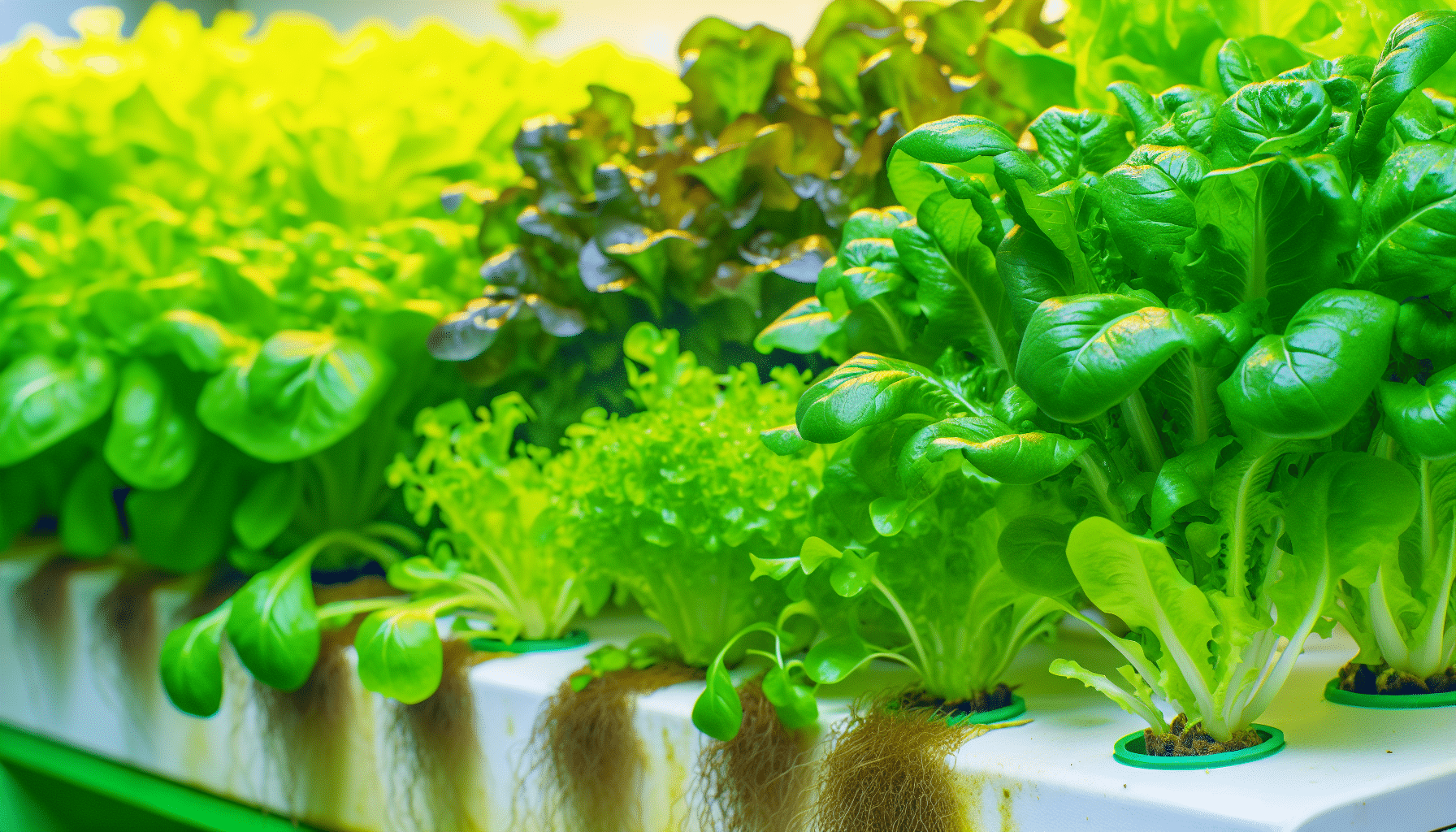
Discover How to Grow Hydroponics: Hydroponic systems are suitable for a diverse range of plants, including leafy greens and various herbs. These plants thrive in hydroponics and grow faster and better compared to those grown in soil. Imagine savouring the crispness of freshly picked lettuce from your hydroponic garden – it’s truly delightful.
Aside from traditional vegetables like leafy greens, there is an entire world of possibilities with hydroponically grown plants waiting to be explored. Some examples include perennial peppers that add spice to dishes, crunchy bok choy, juicy cherry tomatoes perfect for snacking or salads, as well as popular herbs such as basil, mint, and cilantro which can enhance many different recipes.
The options are limitless when it comes to growing produce through hydroponics all year round. This means you no longer have to wait until a particular season or rely on outside factors. You can enjoy your favourite fruits and vegetables whenever desired.
Also Read:
Many hydroponic growers prefer to cultivate leafy greens in their systems. These types of plants, including lettuce, spinach, and arugula, are popular because they require minimal upkeep and have a fast growth time – allowing for an abundant harvest within weeks.
The options for leafy greens in hydroponics are endless. From traditional Romaine lettuce to visually appealing varieties like Red Russian kale, the world of cultivating these nutritious plants is vibrant. Plus, the best part about growing them through hydroponics is that you can enjoy fresh produce all year round thanks to its consistent cycle of cultivation.
Imagine the convenience of having access to fresh herbs within reach, always ready to enhance your cooking. Thanks to hydroponic systems, this is now possible as they can support a wide range of herbs such as basil, chives, cilantro, and dill among others.
When grown in hydroponic environments, these plants tend to thrive more compared to those grown in traditional soil conditions. They also have varying growth times with oregano maturing quickly at 20 days while rosemary takes up an average of 95 days. These diverse herb choices provide unique flavours and aromas that can elevate any dish, not forgetting special types like chocolate or pineapple mint which offer their own distinct taste profiles.
Tomatoes are an essential component of any salad, and with hydroponic systems, you can enjoy a variety of tomato types in vibrant colours. Popular varieties that thrive in hydroponics include cherry tomatoes, beefsteak tomatoes, Roma tomatoes, heirloom tomatoes, and yellow-skinned variants. Adding these freshly grown beauties to your salads not only enhances their flavour but also adds a splash of colour.
For something different yet equally delicious and visually appealing in your salads from the garden or kitchen window, is persimmon tomatoes grown through hydroponics. The unique taste coupled with its distinct hue makes it an exciting addition to your meals. Having such diversity at hand when growing vegetables using the hydroponic method elevates both the cooking experience as well as the aesthetic value of home gardens.
Growing various types of flavorful and colorful ingredients like persimmon-coloured edibles highlights how beneficial adopting hydroponic gardening practices is because they allow one to have access all year round regardless of weather patterns outside.
The abundance achieved by farmers who grow fresh produce amid changing climates proves a crucial investment worth making given fantastic return- tender greens impeccably formed fruits-grown under lighting means customers always satisfied health needs met bringing loyalty among buyers favouring specific greenhouses guarantee commercially needed outcomes plus uplifting relationships between a farmer-clientele base-a place where consumers truly feel welcome being served beautiful colouring rich flavours too great gift indeed!
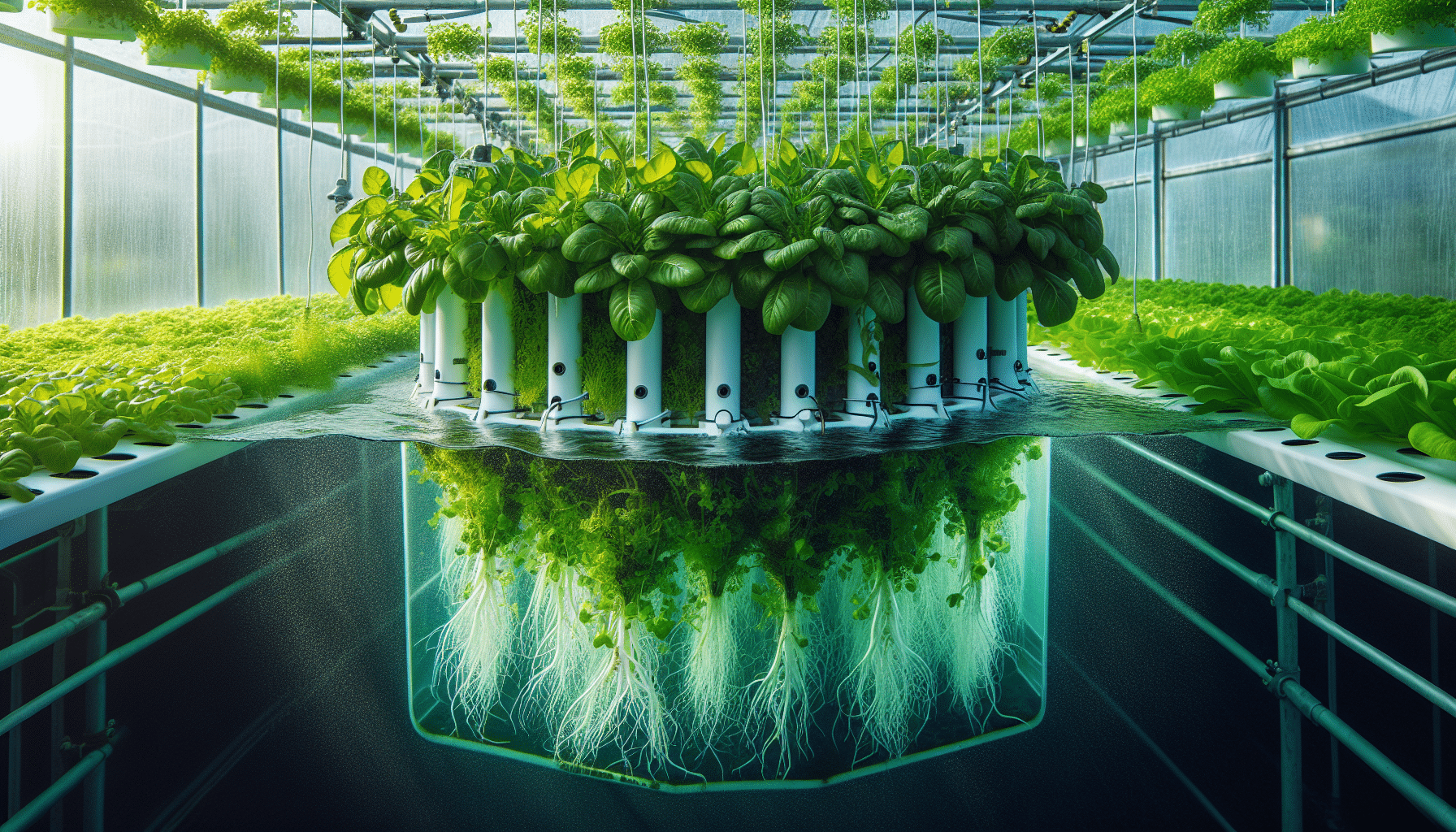
Hydroponic gardening involves more than just soilless plant cultivation. Its main focus is to create the perfect environment that fosters optimal growth for plants. One of its key advantages is precise control over environmental factors such as light, temperature, nutrients, and water, which are crucial in promoting thriving plant life.
Discover How to Grow Hydroponics: These systems provide all necessary components including containers to house plants, grow lights for photosynthesis, suitable growing medium for root support, and nutrient solutions to nourish the plants. Net pots offer enhanced access of oxygen and nutrients to roots resulting in better drainage compared to traditional pots
There are three popular types of hydroponic systems: deep water culture (DWC), nutrient film technique (NFT), and ebb & flow system also known as flood & drain method. Each offers unique benefits but shares a common goal, efficient growth promotion through advanced technology.
The first type, DWC- consists mainly of exposing suspended rooted parts directly into a reservoir filled with a nutritious solution while NFT uses a constant recirculation process where exposed shallow-rooted crops have continuous feeding by way of water.
The deep water culture (DWC) system, also known as a hydroponic method, is a simple yet effective way of cultivating plants. It involves submerging the plant roots in a well-oxygenated and nutrient-rich solution, allowing them to thrive.
What makes DWC so appealing is its simplicity and low maintenance requirements due to the minimal use of mechanical components. Do not underestimate this system’s capabilities – it can be easily adapted and scaled for various applications such as personal home gardens or large-scale commercial operations like urban farms or greenhouses.
Notable for its efficiency, the Nutrient Film Technique (NFT) is a hydroponic system worth mentioning. It operates by using a shallow flow of water that contains dissolved nutrients and circulates it through a sealed channel past an exposed root mat.
Although NFT systems are effective, they do require meticulous management. These setups may not be suitable for plants with extensive root structures and can be sensitive to disruptions in nutrient delivery. When properly managed and with knowledge of the system’s needs, NFT has been shown to promote rapid growth during vegetative stages and early flowering in smaller plants.
The ebb and flow system, also referred to as the ebb and flow setup, is widely known for its versatility in hydroponic environments. These systems can deliver a surge of vital nutrients and oxygen to plants before draining away, allowing their roots ample breathing room.
Due to their adaptable design, ebb and flow systems can accommodate various types of crops such as root vegetables or strawberries. They offer a high level of control over watering schedules that make them suitable for larger operations thanks to their scalability options.
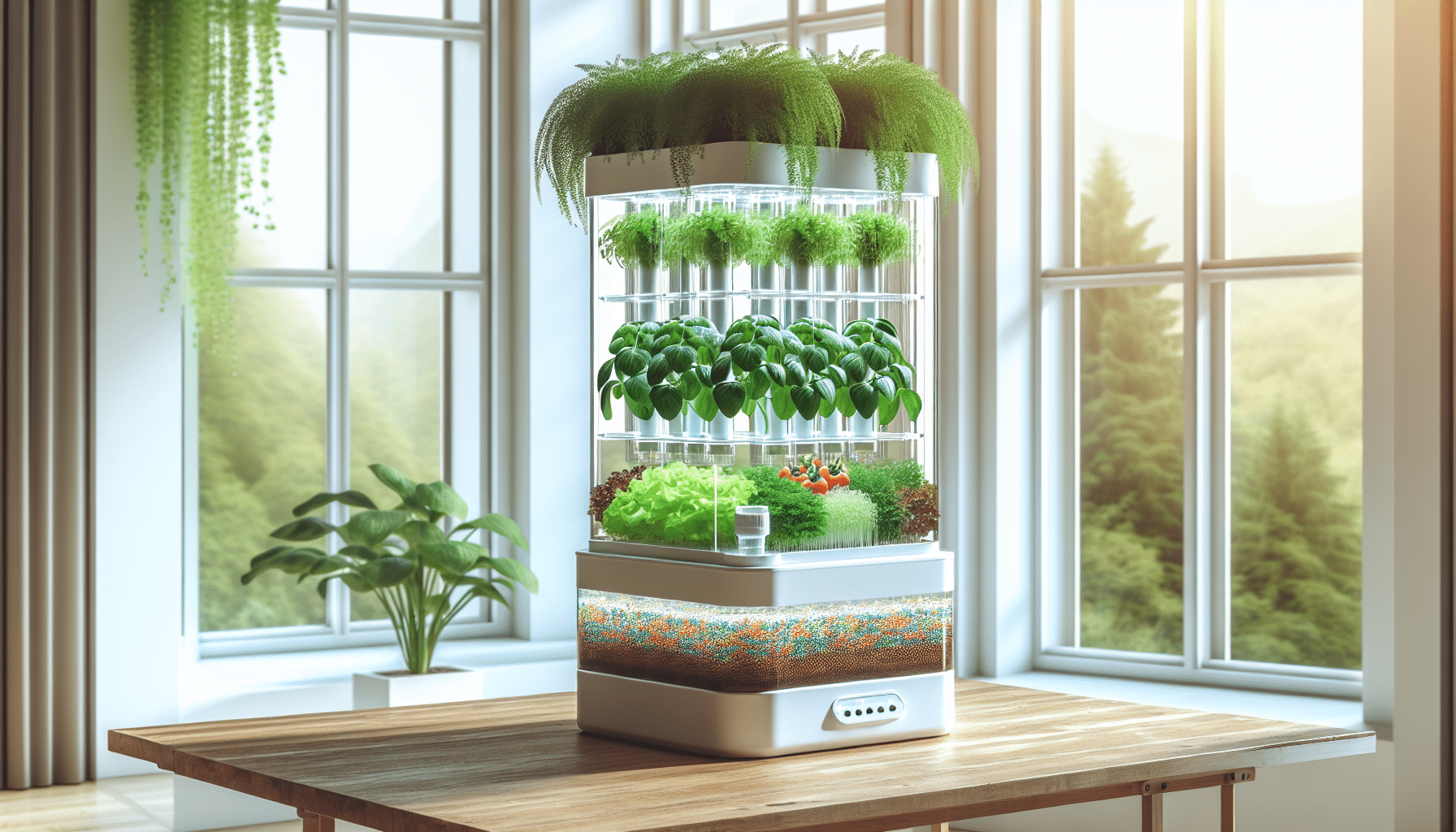
Hydroponic plants, similar to those grown in soil, rely on essential nutrients for their healthy development. In hydroponics, these vital elements are directly supplied to the plants through nutrient-rich solutions, ensuring the timely delivery of necessary nutrients.
The required nutrients can be classified into two groups: macronutrients and micronutrients. Macronutrients such as carbon, hydrogen, oxygen, nitrogen phosphorus, potassium, sulfur calcium, and magnesium are needed in larger amounts, while micronutrient quantities like iron, manganese, zinc, boron, molybdenum, chlorine, and nickel are comparatively less important but equally important for plant growth and progress.
Together these crucial components play a pivotal role in promoting optimal growth conditions for hydroponically cultivated crops.
When it comes to feeding your hydroponic plants, the process is more complex than simply adding fertilizer to water. It requires careful balance and timing for your plants to receive the necessary nutrients at each stage of growth.
From the seedling phase where a weak nutrient solution helps establish strong root systems, to the vegetative phase which calls for high levels of nitrogen to support stem and leaf development, every stage has specific nutritional requirements.
Successfully managing these nutrients, including providing nutrient-rich water, is crucial in promoting healthy plant growth and ensuring a fruitful harvest.
In the world of hydroponic systems, lighting holds a crucial position as it provides plants with the necessary wavelengths and intensities for photosynthesis. Through proper lighting, plants can efficiently transform light into energy, driving their growth and progress.
There are various options available for hydroponic lighting such as fluorescents that are eco-friendly and ideal for the vegetative phase. High-intensity discharge lights are valued for their luminosity output and efficiency. LED lights gaining popularity due to low power consumption along with customization capabilities in terms of specific wavelength selection to enhance plant growth.
Maintaining the appropriate pH levels is just as important in hydroponic gardening as it is in traditional methods. The nutrient solution’s pH can greatly affect the availability of nutrients and ultimately, plant health.
The recommended range for optimal nutrient uptake through hydroponics is between 5.0 and 7.0 on the pH scale. Consistent monitoring and adjustments are necessary to ensure that these levels remain within this range because various factors such as temperature, light exposure, ongoing plant consumption, and nutrient interactions can all impact the overall pH level of a system’s solution.
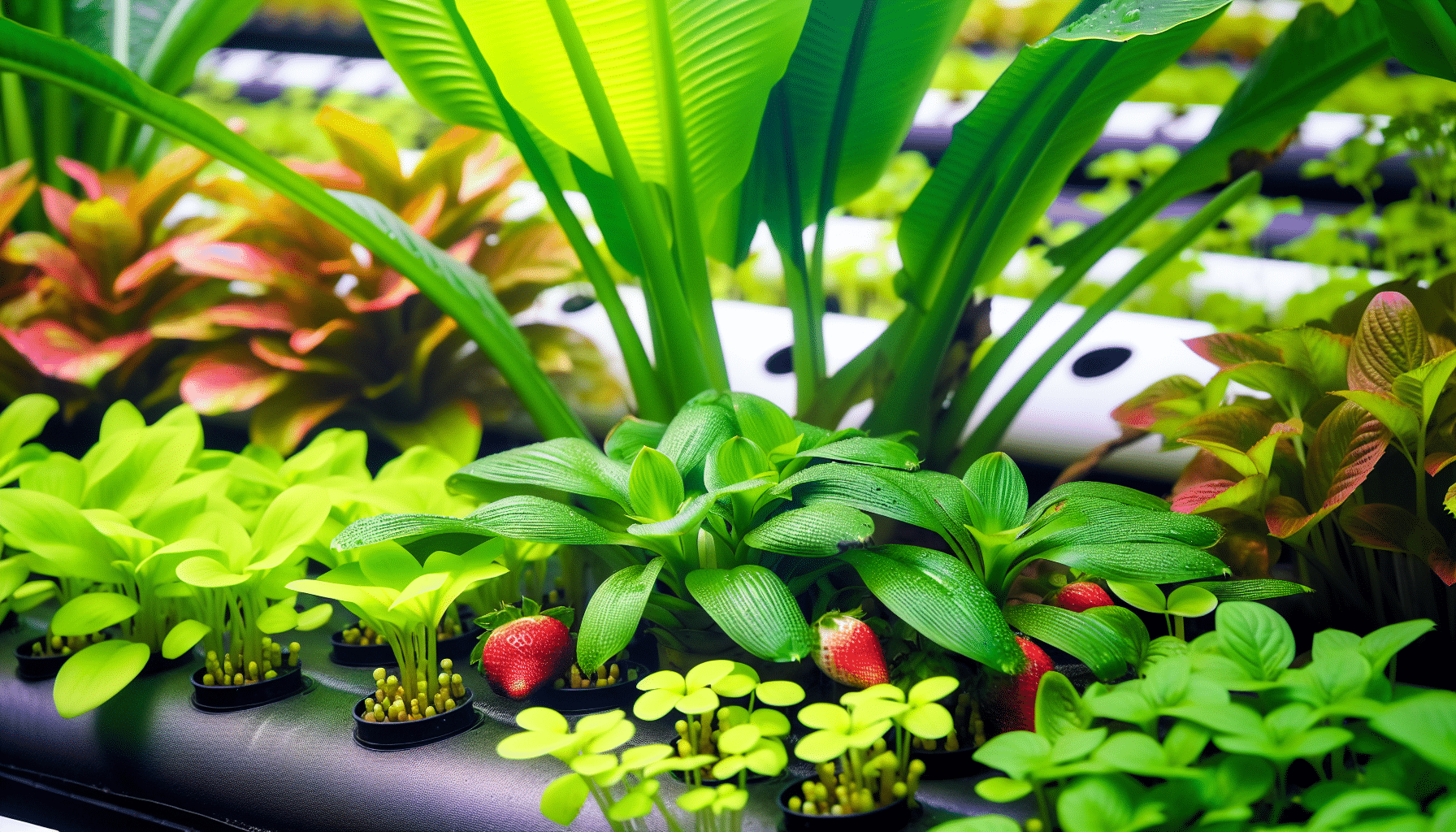
Hydroponic setups are not limited to traditional herbs and vegetables. They can also accommodate the growth of exotic plants, adding new flavours and visual appeal to your garden.
With hydroponics, a whole world of unique plant varieties becomes accessible, from the spicy kick of Mizuna to the salty taste of ice plants. Even candy leaf or stevia leaves, with their natural sweetness, can thrive in hydroponic conditions for convenient use as a sugar substitute.
Experience the possibility of having lush tropical plants, such as strawberries and dwarf banana trees, grow in your very own living room through hydroponics. Say goodbye to seasonal limitations with this innovative method.
Discover a variety of plants that can be easily grown using hydroponic systems, including leafy greens like lettuce or herbs such as basil and mint. To these commonly known options, tomatoes are also among the many crops you can cultivate indoors all year round using this technique.
Hydroponics offers an opportunity for indoor gardening no matter what time of year it is. Among the wide array available on ebb and flow or deep water culture platforms stand out Dwarf Cavendish, Lady Finger, and Gran Nain, perfect candidates when seeking exotic flavours without even leaving home.
Hydroponic systems have a wide range of uses, including supporting the growth of decorative plants that can enhance the beauty and appeal of your indoor garden. One example is orchids, which naturally thrive in hydroponic environments in tropical regions where they are known to take root among rocks or on tree bark.
Another option for adding aesthetic value to your hydroponic setup is by growing arrowhead plants. These low-light tolerant plants make for long-lasting and visually appealing additions to interior water gardens when grown using a hydroponic system.
Whether you’re seeking an eye-catching centrepiece for your living room or some greenery accents for your kitchen, incorporating decorative hydroponic plant options into your home offers a versatile and attractive solution with many possibilities.
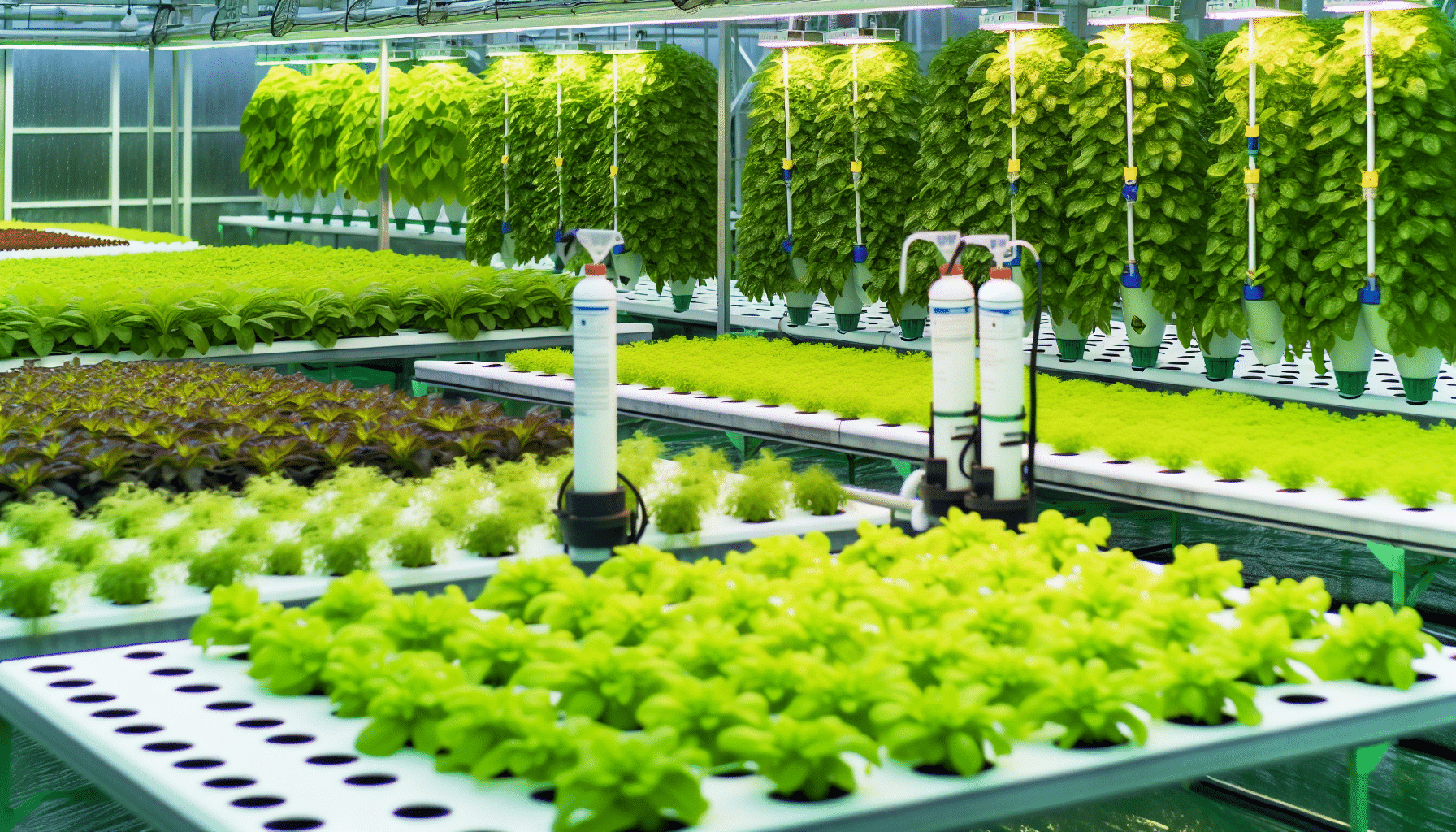
Just like any other gardening technique, hydroponic gardening also presents its own set of obstacles. These can range from managing nutrient imbalances to dealing with pests and fluctuations in pH levels. By having the right knowledge and implementing effective strategies, these challenges can be overcome leading to a flourishing garden. Some commonly encountered hurdles in hydroponics include:
Nutrient deficiencies or excesses
Fluctuations in pH levels
Unwanted growth of algae
Root decay due to excessive moisture retention
-Pest invasions
By familiarizing yourself with these common issues and employing suitable solutions, you can ensure the success of your hydroponic garden.
In this next section, we will discuss some frequently faced difficulties associated with hydroponic gardening while also suggesting ways to mitigate them effectively. Whether you are new at it or have prior experience, gaining an understanding of such roadblocks is crucial for achieving thriving plants.
Hydroponic gardens come attached not only with benefits but also with certain barriers. Algae buildup on surfaces, the risk accompanying too much moisture together known as root rot, and invasive bugs alongside unbalanced amounts of nourishment supplied are prone causes that may hinder maintenance. Having substantial comprehension regarding them helps us overcome which leads us towards nurturing a successful homegrown atmosphere.
Effective management of nutrients is a major challenge in hydroponics. Imbalances can lead to either deficiencies or toxicities, posing risks to plant health if not addressed promptly.
To ensure the well-being of your plants, it is crucial to regularly test and monitor electrical conductivity and pH levels in the nutrient solution. It’s also important to replenish the nutrient solution reservoir consistently. Maintaining an optimal balance requires careful attention, but with diligent monitoring and necessary adjustments, you can create a nourishing environment for healthy plant growth.
In hydroponic systems, proper air circulation is crucial for maintaining the health and growth of plants. It plays a vital role in providing adequate oxygen levels to plant roots.
Insufficient air circulation can result in various issues such as plant stress, higher vulnerability to diseases, and root zone overheating. In contrast, consistent and cool airflow helps regulate optimal root temperature, which contributes significantly towards cultivating healthier and happier plants.
As with traditional gardening, hydroponic systems are also vulnerable to pest attacks. Some of the common pests found in such setups include whiteflies, spider mites, thrips, aphids, and fungus gnats. These pesky insects can cause serious harm to your hydroponic system.
To prevent and combat these pests in a hydroponic environment, several methods can be used, including introducing parasitic wasps or utilizing sticky traps. Other options include using neem oil sprays or insecticidal soap solutions as treatment measures.
To treatments against infestations by unwanted creatures, paying attention to cleanliness is key for maintaining a healthy hydroponic system. Timely monitoring and taking necessary precautions play an important role in preventing pest outbreaks from causing damage to your plants. It is crucial to keep up with proper maintenance practices for keeping the hydroponic system free from harmful intruders.
As you gain more experience in hydroponic gardening, it may become appealing to explore advanced methods for enhancing your system. These techniques can aid in increasing yield and improving overall satisfaction with the gardening process.
Whether you are interested in customizing drip systems or diving into aeroponics, these sophisticated techniques offer a higher level of precision and optimization for hydroponic gardening. Now let’s take a closer look at these advanced approaches.
Experienced hydroponic gardeners often favour the use of drip systems due to their precise control over water and nutrient distribution, making them a great choice for meeting the unique requirements of different plants.
The artful mastery of a drip system involves fine-tuning emitter flow rates and carefully regulating the frequency and volume of nutrient delivery. While this method requires consistent monitoring and adjustments, the result is well worth it – robust, thriving plants with high yields.
Exploring advanced systems like aeroponics can take hydroponic gardening to the next level. These innovative setups expose plant roots to air and regularly spray them with water and nutrients, providing easy access to oxygen.
The use of high-tech methods opens up endless possibilities in hydroponic gardening. Vertical aeroponic systems, for example, maximize space usage and ensure all plants receive sufficient sunlight exposure. Through data analysis and monitoring software implementation, you can optimize conditions for plant growth and increase productivity like never before.
The growth of a hydroponic plant begins with the use of seeds. Each stage in its life, from sprouting to seedling and then to vegetative and flowering, comes with specific requirements and challenges.
By providing proper care and attention, you can effectively guide your plants through each phase by ensuring they receive adequate nutrients, light exposure, and environmental conditions. And when it’s time for harvest season arrives, you will reap the rewards of fresh produce that is grown directly within your hydroponic garden.
This guide covers everything from the basics of hydroponic systems to advanced techniques for nutrient management. Hydroponic gardening is a unique method of growing plants that offers numerous benefits, including space efficiency, year-round growth potential, and high-quality produce. Whether you’re new to gardening or have years of experience under your belt, hydroponics presents exciting opportunities for cultivating a wide variety of plants. Don’t wait any longer – dive into the world of hydroponics and start on your path toward a greener, healthier future with sustainable practices.
In hydroponics, a variety of plants are typically cultivated including leafy greens such as arugula, lettuce, spinach, herbs, and fruits like tomatoes, peppers, and cucumbers. Other options include strawberries and celery depending on how they can be nourished by the nutrient solution in use.
Hydroponic systems are ideal for growing lettuce, spinach, strawberries, bell peppers, and herbs. These plants thrive in hydroponic gardens due to their adaptability to this method of cultivation.
Hydroponic cultivation of leafy greens, including lettuce, spinach, and kale, is known for its speediness and high nutritional value. With proper techniques in place, these plants can be ready to harvest within 7-60 days.
It is possible to cultivate a range of plants in a hydroponic system, such as leaf lettuce, tomatoes, peppers, cucumbers, strawberries, watercress, and certain herbs. The selection of crops may be influenced by the design of the system and the time of year.
Some suitable options for growing include celery as well. Ultimately, success lies in choosing wisely what would thrive best according to one’s setup at hand when utilizing this type of cultivation method. It should also not go without mention that while having good produce, you can try out some good produce.
Hydroponic systems function by providing plants with a solution containing essential nutrients, removing the reliance on soil and enabling direct absorption of necessary substances for their growth and progress. This method greatly enhances productivity and supports robust plant development while also ensuring its overall health is maintained.
Grow 100 planting sites, monitor ph levels, water temperature, water levels, and control light and water cycles.
© Copyright 2024 Nutraponics. All Rights Reserved.